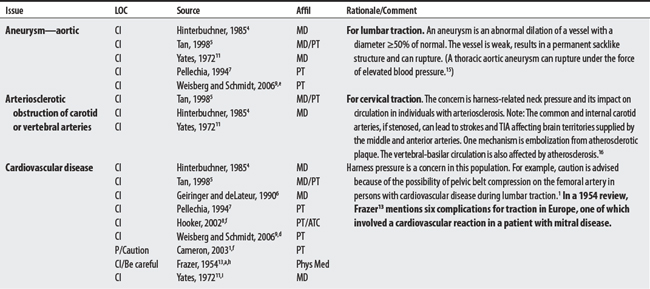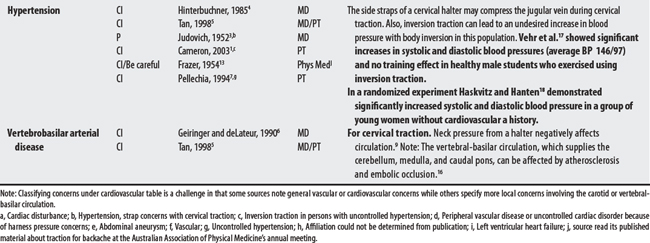Chapter 51 Spinal Traction
(Includes Mechanical and Inversion Traction) (Excludes Manual Traction)
OVERVIEW.
The proposed mechanisms for traction include (1) gating out pain transmissions, (2) interrupting the pain-spasm cycle, (3) reducing pressure on pain-sensitive structures (reducing the disc’s bulge that compresses a nerve root), and (4) increasing the size of the foramen opening.1
Traction can be administered mechanically (using an electric motor), manually (using hands), and positionally. Mechanical traction devices typically include an electric motor, a cable, and a harness or device that is secured to the patient’s body. Inversion traction is a special case of positional traction whereby individuals use their own body weight (often hanging upside-down from boots) to exert traction forces on the low back. This section will report on spinal traction applied mechanically or through inversion.1
SUMMARY: CONTRAINDICATIONS AND PRECAUTIONS.
Ten sources cited a total of 51 concerns for spinal traction. Approximately 40 and 43 concerns are relevant to lumbar and cervical traction, respectively. Concerns ranged from 5 to 29 per source, with a physical therapist citing the greatest number. The largest proportion of concerns was musculoskeletal (24%). Whereas digestive (i.e., hernia, hemorrhoids, peptic ulcer) and respiratory concerns were particular to lumbar traction, TMJ, denture, and C1-C2 stability issues were particular to cervical traction. Overall, the most frequently cited concerns were malignancy, cardiovascular disease, and osteoporosis.
OTHER ISSUES.
The FDA2 received nine reports of mechanical traction malfunctioning between February 1985 and July 2000 that allegedly have resulted in soft tissue injury, including increased symptoms, pain, and contusions. The devices exceeded the load setting, released cord tension unexpectedly, or fell from an unsecured position.
CONTRAINDICATIONS AND PRECAUTIONS FOR TRACTION
D50-D89 DISEASES OF BLOOD AND BLOOD-FORMING ORGANS, AND CERTAIN DISORDERS
F00-F99 MENTAL AND BEHAVIORAL DISORDERS
G00-G99 DISEASES OF THE NERVOUS SYSTEM
I00-I99 DISEASES OF THE CIRCULATORY SYSTEM
< div class='tao-gold-member'>
Stay updated, free articles. Join our Telegram channel

Full access? Get Clinical Tree

















